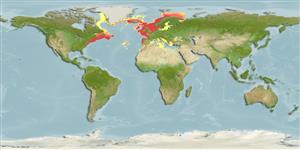Preferred temperature (Ref.
115969): 7 - 17.5, mean 10.2 (based on 2460 cells).
Phylogenetic diversity index (Ref.
82804): PD
50 = 0.5625 [Uniqueness, from 0.5 = low to 2.0 = high].
Bayesian length-weight: a=0.00646 (0.00585 - 0.00713), b=3.07 (3.04 - 3.10), in cm Total Length, based on LWR estimates for this species (Ref.
93245).
Trofisk nivå (Ref.
69278): 3.6 ±0.2 se; based on diet studies.
Resiliens (Ref.
120179): Mellan, lägsta populationsfördubblingstid 1,4-4,4 år (rm=0.33-0.56; K=0.23-0.27; tm=2-3; tmax=17; Fec=200,000).
Prior r = 0.43, 95% CL = 0.28 - 0.64, Based on 10 full stock assessments.
Fishing Vulnerability (Ref.
59153): Low to moderate vulnerability (30 of 100).
Climate Vulnerability (Ref.
125649): Low vulnerability (10 of 100).
